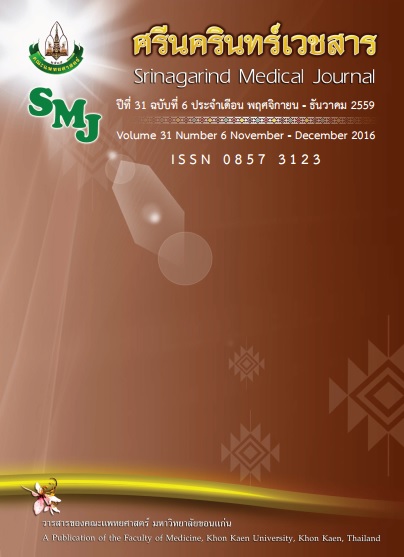The Prevalence and Associated Factors of the Chronic Pyelonephritis among the Hypertensive Patients at Phukieo Hospital, Chaiyapoom Province
Keywords:
Modified Fist test, Isarn Syndrome, chronic pyelonephritis, hyperuricemia, purine rich food, Chronic Kidney Disease, การเคาะหลังแบบประยุกต์, อีสานรวมมิตร, กรวยไตอักเสบเรื้อรัง, ภาวะยูริกในเลือดสูง, อาหารพิวรีนสูงโรคไตเรื้อรังAbstract
Background and Objectives: Hypertension (HT) increases the risk of developing hyperuricemia, kidney stone. Undiagnosed chronic urinary tract infection may have not been treated properly; this may eventually lead to chronicpyelonephritis (CPN) andchronickidneydisease. This study aims to investigate the prevalence and associated factors of CPN in HT
Method: Ahospital-based cross sectional studyfor CPN was performed amongthe HTaged ≥ 30 years in Phukieo hospital,ChaiyapoomPrivince. Systematic sampling method was performed.
Results: In this study, 204 participants were involved, 73.5% of which were females and the average age was 63.2±10.8years. Most of the patients (37.7 %)were farmers.Prevalence of Cronic Kidney Disease(CKD)stage 3-5(eGFR<60 ml/min/1.73 m2),Microalbuminuriaand hyperuricemiawere27.0 ,44.6 and 39.7 percent ,respectively. The prevalence of CPN in the hypertensive patients was14.2%. The associated factors for CPNweredehydration,symptoms aggravated when consuming bamboo shoot ,Isarn syndrome (ISS) and urinary crystal or sludge[with oddsratio(95%CI) of 4.81 (1.57, 14.77), 2.40 (1.07, 5.38)and2.28 (1.03, 5.08), respectively]. The prevalence of ISS was41.2% in the HT with CPN.
Conclusions: In the HT, approximatelymore than one fourth developed CKD stage3-5 and one seventhhad concurrent CPN. We recommendscreening the CPN by the history of aggravated symptomswhen consumed bamboo shoots or the MFT.
ความชุกและปัจจัยที่สัมพันธ์กับผู้ที่มีภาวะกรวยไตอักเสบเรื้อรังในผู้ป่วยผู้ป่วยความดันโลหิตสูง กรณีศึกษาที่โรงพยาบาลภูเขียว จ.ชัยภูมิ
หลักการและวัตถุประสงค์:โรคความดันโลหิตสูง (HT) เพิ่มความเสี่ยงในการเกิดภาวะกรดยูริกในเลือดสูงนิ่วในไต การติดเชื้อทางเดินปัสสาวะ และหากไม่ได้รับการวินิจฉัยและรักษาที่เหมาะสม อาจนำไปสู่การเป็นโรคกรวยไตอักเสบเรื้อรัง (กตร.) และไตวายในที่สุดการศึกษานี้จึงมีวัตถุประสงค์เพื่อศึกษาความชุกและปัจจัยที่มีความสัมพันธ์กับ กตร.ในผู้ป่วย HT
วิธีการศึกษา: เป็นการศึกษาเชิงวิเคราะห์แบบภาคตัดขวาง (Cross sectionalstudy)
ทำการสุ่มตัวอย่างโดยวิธี systematic sampling ในผู้ที่มีอายุตั้งแต่ 30 ปีขึ้นไป จากผู้ป่วยHTที่มารับบริการที่คลินิกผู้ป่วยนอก โรงพยาบาลภูเขียว
ผลการศึกษา:จำนวนตัวอย่างที่ศึกษา 204 ราย5ส่วนใหญ่เป็นเพศหญิงร้อยละ 73.5 อายุเฉลี่ย 63.24±10.79 ปี ประกอบอาชีพเกษตรกรรมร้อยละ 37.7 พบความชุกของภาวะโรคไตเรื้อรัง(eGFR<60 ml/min/1.73 m2), ภาวะ Microalbuminuriaและภาวะกรดยูริกในเลือดสูง เป็น ร้อยละ 27.0 , 44.6 และ 39.7 ตามลำดับพบความชุกของ กตร.ร้อยละ 14.2 พบความสัมพันธ์ระหว่าง กตร.กับตัวแปรที่สำคัญดังต่อไปนี้ คือ ดื่มน้ำน้อยมีอาการผิดปกติเมื่อบริโภคหน่อไม้อาการอีสานรวมมิตร (อสร.) และโดยมีค่า OddsRatio (95%CI) เท่ากับ 4.81 (1.57, 14.77), 2.40 (1.07, 5.38) และ 2.28 (1.03, 5.08) ตามลำดับ ในผู้ป่วย กตร.พบความชุกของ อสร.ร้อยละ 41.2
สรุป: ในผู้ป่วย HT มากกว่า 1ใน 4 มี ปัญหาโรคไต้เรื้อรังระดับ3 ขึ้นไป และประมาณ 1 ใน 7เป็นกตร.อาจคัดกรองภาวะ กตร.ในผู้ป่วยความดันโลหิตสูงโดยประวัติผิดปกติเมื่อบริโภคหน่อไม้หรือการทำ Modified first test;MFT




